

If you’re hurting, missing work, and watching bills pile up, the timeline matters. The honest answer is that no two cases move at exactly the same pace. In Suffolk County, straightforward claims sometimes resolve within a few months, while contested or serious-injury cases can take a year or more—especially if a lawsuit becomes necessary. Below is a clear, local walk-through of what actually drives the timetable and what you can do to keep your case moving without sacrificing value.
These are patterns, not promises. Your facts, injuries, and insurer all matter.
1) Medical recovery and “maximum medical improvement” (MMI)
Insurers pay for proven, documented harm. That means your attorney typically waits until your treatment stabilizes or a doctor can credibly project future care. Settling before you understand the long-term picture can leave money on the table.
2) Liability clarity
Rear-end car crashes with police reports and witnesses usually move faster. Cases with disputed fault, limited witnesses, or unclear site conditions (e.g., a trip-and-fall where notice must be proved) take longer because evidence must be built.
3) Insurance coverage and liens
If there’s limited coverage, settlement can go quicker—once injuries are known—because the policy can cap negotiations. If Medicare/Medicaid, workers’ compensation, or ERISA plans paid some of your bills, lien resolution adds time at the back end.
4) Venue and defendant type
Suffolk County personal injury lawsuits are filed in New York Supreme Court (the state’s main civil trial court). Court schedules, judicial assignments, and motion practice influence timing. If a municipality is involved, New York law requires a Notice of Claim and a 50-h hearing before suit, which adds steps.
5) The insurer’s posture
Some carriers evaluate promptly; others drag their feet. Prior verdicts, local norms, and the strength of your documentation all affect how fast reasonable offers appear.
You get treatment, report the crash or incident, and your attorney gathers key proof: photos, 911 recordings, bodycam or surveillance where available, witness statements, event reports, and scene inspections. In motor vehicle cases, New York’s No-Fault system requires a timely application so medical bills and lost wages are paid while the case develops.
Once your care reaches a plateau, or a surgeon can forecast future needs, your lawyer compiles a demand with medical records, bills, wage loss proof, and a liability narrative. Adjusters often take 30–90 days to review, then negotiations begin. Many straightforward claims settle here.
If the offer is unfair, suit is filed. The defendant answers, insurance defense counsel appears, and the court issues a Preliminary Conference order setting discovery deadlines.
Throughout litigation, settlement is possible at any time—after depositions, following a defense medical exam, at mediation, or literally in the hallway before jury selection.
Speed feels good, but a quick check isn’t always a fair check. If you’re still in active treatment, don’t yet know whether you’ll need injections or surgery, or haven’t returned to your prior job duties, a fast resolution can underpay future medical costs, future lost earnings, or non-economic damages like pain and loss of enjoyment of life. The case should move as quickly as complete documentation allows.
Filing is often the right move when an insurer won’t engage reasonably after a well-supported demand, or when future damages are significant. Lawsuits add court oversight, deadlines, and leverage through depositions and trial exposure. Many Suffolk County cases still settle after filing, sometimes for substantially more, once the defense sees the proof developed under oath.
Your case should move as fast as your proof allows. The goal is not to wait needlessly, but to reach the point where your injuries, future care, wage loss, and long-term impact are documented so an insurer, or a jury, can see the full picture. In Suffolk County, that can be a few months for simpler matters or a year or more for serious or disputed cases, with settlement opportunities along the way.
Need a clear timeline for your specific situation? Palermo Law has represented injury victims across Suffolk County for over three decades. We’ll map out the likely path, keep your case moving, and protect the full value of your claim. Contact Palermo Law for a free consultation—let’s talk about your goals and the best strategy to reach them.